the place where Paleontology and Paleoanthropology meets Philately
Romania
Fossils and reconstructions of dinosaurs and other prehistoric animals,
paleontologists, Charles Darwin, Natural History Museum, fossil found places on stamps,
postmarks and postal stationeries of Romania
| << previous country | back to index | next country >> |
Contents:
- Country overview
- Philately of Romania
- Official stamps of Romania related to Paleontology
- Other stamps of Romania to consider
- Postal stationery of Romania related to Paleontology
- Other postal stationery of Romania to consider
- Commemorative covers of Romania related to Paleontology
- Commemorative postmarks of Romania related to Paleontology
- Other commemorative postmarks of Romania to consider
- References
- Acknowledgements
Romania, is a sovereign state located in Southeastern Europe. It borders the Black Sea, Bulgaria, Ukraine, Hungary, Serbia, and Moldova.
It has an area of 238,391 square kilometres and a temperate-continental climate, with population of 20 million. Its capital and largest city is Bucharest. Modern Romania emerged within the territories of the ancient Roman province of Dacia, and was formed in 1859 through a personal union of the Danubian Principalities of Moldavia and Wallachia.
The new state, officially named Romania since 1866, gained independence from the Ottoman Empire in 1877. At the end of World War I, Transylvania, Bukovina and Bessarabia united with the sovereign Kingdom of Romania.
In June–August 1940, as a consequence of the Molotov–Ribbentrop Pact and Second Vienna Award, Romania was compelled to cede Bessarabia and Northern Bukovina to the Soviet Union, and Northern Transylvania to Hungary.
In November 1940, Romania signed the Tripartite Pact and, consequently, in June 1941 entered World War II on the Axis side, fighting against the Soviet Union until August 1944, when it joined the Allies and recovered Northern Transylvania.
Following the war and occupation by the Red Army, Romania became a socialist republic and a member of the Warsaw Pact. After the 1989 Revolution, Romania began a transition back towards democracy and a capitalist market economy. [R1]
The first stamps inscribed "POSTA ROMANA" were issued in January 1865; the three values depicted Prince Alexandru Ioan Cuza in profile, facing right. In 1891, Romania issued its first commemorative stamps, a series of five in which the usual profile of the king was framed by an inscription marking 25 years of his reign. In 1896, Romanian stamps were overprinted in Turkish currency for use on ships passing between Constanța and Constantinople. In 1903 the first pictorial designs were issued to note the opening of a new post office in Bucharest, followed by a series of 10 designs in 1906, for the 40th anniversary of Carol's reign. [R2]
Official stamps of Romania related to Paleontology: fossils, dinosaurs and other prehistoric animals, paleontologists, Charles Darwin
| 25.04.1959 "Famous personalities" [1] | 20.06.1962 "Famous personalities" [2] | 25.11.1966 "Prehistoric animals" |

|

|

|
| 29.07.1967 "Famous personalities" [3] | 30.07.1993 "Prehistoric animals" | 30.04.1994 "Dinosaurs" |

|

|

|
| 26.07.2001 Surcharged from 1994 | 25.02.2005 "Dinosaurs from Tara Hategului - Romania" | |

|

|

|
| 19.01.2007 "100 years since the foundation of biospeleology by the Romanian scientist Emil Racovita" [A3] | ||
 |

|
 |
| 22.01.2016 "Prehistoric animals" (issued in Sheets and two Mini-Sheets formats) | ||
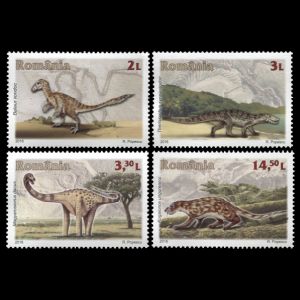 |
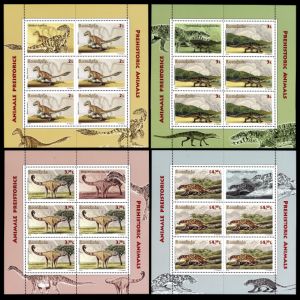
|
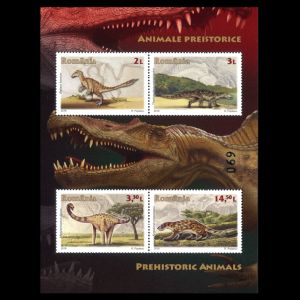 |
| 18.06.2020 "Institute of Speleology 'Emil Racovita', a century of research" [4] | ||
 |
|
|
Notes:
[1] Charles Darwin is depicted on the gray stamp among other famous personalities

|
| Charles Darwin on international stamps of year 1959 |
Many countries issued stamps and postmarks to commemorate the 200th anniversary of Charles Darwin’s birth and 150th anniversary of the publication of “On the Origin of Species by Means of Natural Selection”. Only a handful of countries issued stamps in Charles Darwin’s honor for the 150th anniversary of his birth and 100th anniversary of the publication of his most significant work. The five countries that released stamps in 1958-1959 were all communist countries and included GDR (in 1958), USSR, Czechoslovakia, Romania and Poland.
[2] Famous Romanian geologist and paleontologist, member of the Romanian Academy in 1886 Grigore Cobilcescu (Sometimes spelled Cobalsescu) (1831 -1892 ) shown on light blue stamp of the set.
He was the first professor of geology and mineralogy at the University of Iasi. He developed the first Romanian book on geology, "The Limestone at Repedea" (1862), in which he agrees with the Catastrophic interpretation of the fossil record after Cuvier.
After learning about Darwin’s theories, Cobilescu became one of the most ardent supporters of Darwin’s evolutionary theory in Romania.
He researched stratigraphy, petrography and paleontology - especially in the Eastern Carpathians. The results of this study are included in his most acclaimed work “Geological and Paleontological Studies of Certain Tertiary Formations in Some Parts of Romania” (1883).
After known Darwinism, Cobalcescu returned on his own and has become one of the most ardent supporters of this view in Romania. He did research stratigraphy, petrography and paleontology, especially on the Eastern Carpathians. The results of studies are included in the work accestor "Studies on the geology and paleontology of Tertiary realms of some parts of the Eastern Carpathians". [R4]
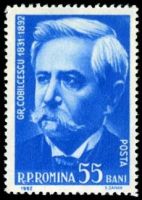
|

|
| Romania paleontologist Grigore Cobilcescu on stamp of Romania 1962 MiNr.: 2073, Scott: 1495 | Grigores Antipa and fossil of Dinotherium giganteum on stamp of Romania 1967 MiNr.: 2609, Scott: 1941 |
[3] Fossil of Dinotherium giganteum depicted on a background of the green stamp, dedicated to Grigores Antipa (1861-1944). He founded the Romanian school of hydrobiology, ichthyology and oceanography, pioneer in the field of museology, the author of modern concepts in ecology, biosociology and biosphere.
He was Director of the Museum of Natural History in Bucharest, where he made important contributions to the organization of the phylogenetic and ecological collections.
As a token of gratitude for his work in the museum since 1933, the Museum of Natural History bears his name. The Dinotherium is the most expressive artifact of the museum.
Some website and even catalogues mention this stamp as the first stamp depicting a paleontologist. Unfortunately, this is not accurate, as G. Antipa was a biologist and not a paleontologist.
The presence of Dinotherium giganteum in the background of the stamp likely gave people a wrong impression that G. Antipa was a paleontologist. As theDinotherium giganteum fossil is a highlight of the Museum, it has appeared on both this stamp and on the margin of the mini-sheet “Centenary of the Natural History Museum” in 2008. [R3]
[4] The third stamp of the issue, with the value of Lei 8.50, shows the cave bear skulls found in the Rece (Cold) Cave, the bear being the representative mammal of the last Ice Age in the Carpathians. The Rece Cave is located on the left slope of Cutilor Gorges, from Rosia Township, Bihor County.
Other stamps to consider: contributors to Paleontology science, Natural history museums, fossil found places, prehistoric animals on margins
| 31.05.1958 "Famous personalities" [A1] | 28.08.1958 "10 years since death of Emil Racovita" [A3] | 22.06.1961 "Wildlife & Hunting" [A2] |
 |
 |
 |
| 24.06.1968 "150th anniversary of Ion Ionescu de la Brad; 100 birth anniversary of Emil Racovita" [A3] | 25.01.1976 "200 years of USA independence" [A4] | 18.08.1997 "Centenary of the Start of the Antarctic Expedition with the 'Belgica' " [A3] |
 |
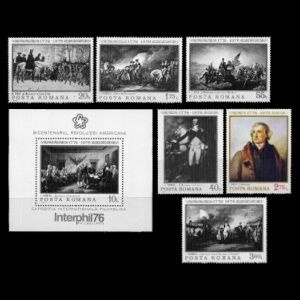 |
 |
| 22.03.1999 "Bugs with overprinted values" [A5] | 20.05.2008 "Centenary of National Natural History Museum" | 17.02.2011 "Romanian Caves" [A3] |
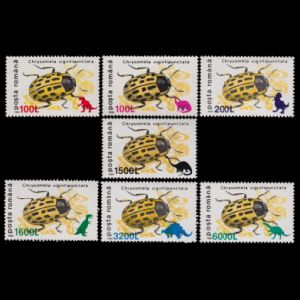 |
 |
 |
| 20.09.2014 "555th Anniversary of Bucharest" [A6] | ||
 |
|
|
Notes:
[A1] Carl von Linné (1707 - 1778) Sweden Carl Linnaeus, was a Swedish botanist, physician, and zoologist, who laid the foundations for the modern scheme of binomial nomenclature used in all biologically related sciences, including paleontology. He is known as the father of modern taxonomy, and is also considered one of the fathers of modern ecology. [R7]

|
| Prehistoric hunter on stamp of Romania 1961 MiNr.: 1982, Scott: 1426 |
[A2] In June 1961, Post Authority of Romania issued a set of 10 stamps "Wildlife & Hunting".
Wild animal shown on foreground and a hunter on a background. The stamp with face value of 20 bani, with Lynx on foreground shows a hunter with a spear depicted on the background, perhaps a prehistoric human from the stone age.
[A3] Emil Racovita (1868-1947) was a Romanian biologist, zoologist, speleologist and explorer of Antarctica. Together with Grigore Antipa, he was one of the most noted promoters of the natural sciences in Romania. Racovita was the first Romanian to have gone on a scientific research expedition to the Antarctic, more than 100 years ago, as well as an influential professor, scholar and researcher.
He found and described several fossils in caves he was observing, for example Ursilor Cave which is depicted on stamp of 2011 (face value 0.30 L). The cave was discovered in 1975. The name of the cave originates from the numerous cave-bear fossils discovered here, being an appropriate shelter for animals for more than 15,000 years.
They believe that the cave entrance was blocked by a fallen rock so that more than 140 bears attacked each other because of hunger. In September 1975, a group of amateur speleologists from "Speodava" Club explored the cave for the first time and 5 years later it was opened for tourists. One of the bear fossils and its reconstruction is shown on stamp of 2007 and the cave shown on the stamp from 2011. [R5]
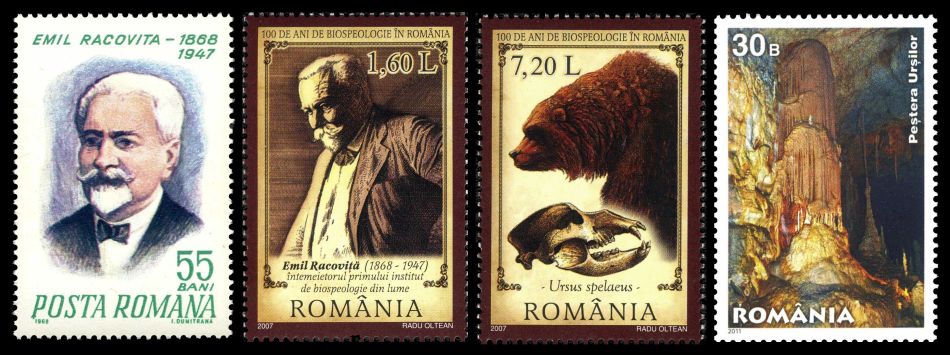
[A4] Thomas Jefferson, the 3rd American president, author of the Declaration of Independence depicting on one of these stamps. He was also a central player in the beginnings of American paleontology.
In addition, his participation occurred at a time when people were struggling with the ideas of fossils as evidence of past life, of extinction, and of an Earth far older than the Biblical account.
Some of the fruits of Jefferson's paleontology became part of the collections at the American Philosophical Society in Philadelphia.
Beginning in 1849 these holdings were transferred over to the Academy of Natural Sciences of Philadelphia, where they are currently housed.

|
| National Geology Museum of Romania on stamp of Romania 2014 MiNr.: 6872, Scott: |
Note: The stamp of Thomas Jefferson was issued in 1851 is the first Paleontology related stamp.
[A5] Various dinosaur silhouettes used as overprint label on surcharged bug stamp of Romania 1999 to cover the old face values.
Original stamps were issued in 1996.
[A6] National Geology Museum of Romania, located in Bucharest, shown on stamp with face value of 9.10L.
The museum hosts a collection of 80,000 samples of rocks, fossils, and minerals from Romania. [R8]
Postal stationeries related to Paleontology: fossils, dinosaurs and other prehistoric animals
| ? "Natural History Museum - Gr. Antipa" | ? "Fossils from Petroșani Mining Museum" [PS1] | |
 |
 |
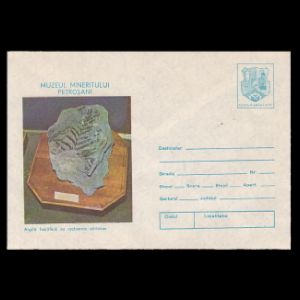 |
| 1994 "Prehistoric animals" | ||
 |
 |
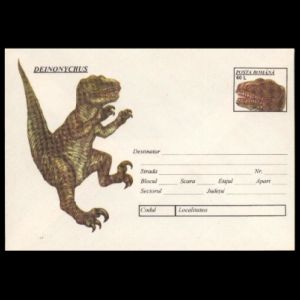 |
| 1994 "Prehistoric animals" | 1999 "Australanthropus Olteniesis" | 19.01.2007 "100 years since the foundation of biospeleology by Romanian scientist Emil Racovita" [A3] |
 |
 |
 |
Notes:
[PS1] The Petroșani Mining Museum (Romanian: Muzeul Mineritului Petroșani) is a museum focused on coal mining and located in the Jiu Valley city of Petroșani, Hunedoara County, Romania.
The collection includes some 1500 items related to mining, including some unearthed fossils.
It is the country's only museum that focuses on coal-mining technology. [R6]
Other postal stationeries of Romania to consider: Natural History Museums, stylized prehistoric animals
| 20.05.2008 "150th anniversary of Grigore Antipa" [FDC] [PSO1] | ||
 |
|
|
Notes:
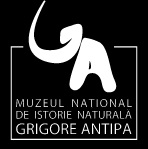
 [PSO1] 150th anniversary of Grigore Antipa. [3]
[PSO1] 150th anniversary of Grigore Antipa. [3]He was director of the Museum of Natural History in Bucharest, where he made important contributions to the organization of the phylogenetic and ecological collections.
As a token of gratitude for his work in the museum since 1933, Museum of Natural History bears his name.
Imprinted stamp on the postal stationery shows the logo of the museum with silhouette of Mammoth.
The mammoth and Dinotherium giganteum (depicted for the first time on Romanian stamp in 1967) are most impressive and popular artefacts of the museum.
Set of 2 mint stamps issued on the same date with Dinotherium giganteum on tab at top-left corner of every Mini-Sheet.

Commemorative covers related to Paleontology: fossils and reconstructions of prehistoric animals on cachets
| 1982 "Natural History Museum, named after Grigore Antipa" | 1992 "125th anniversary of Grigore Antipa" [3] | 1993 "Prehistoric animals" [COV1] |
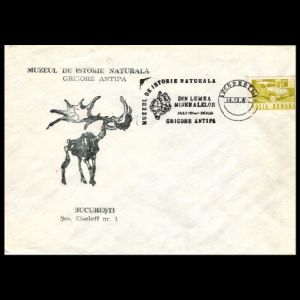 |
 |
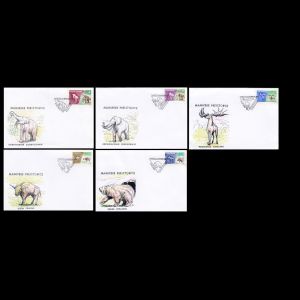 |
| 1993 "Dinosaurs" [COV2] | ||
 |
Notes:
[COV1] These covers are not FDC, as they looks like. The postmarks dated 16.02.1993, but the stamps were issue on November 25th 1966.
[COV2] These covers are not FDC, as they looks like. The postmarks dated October 23rd 1993 , but the stamps were issue on July 30th 1993
Commemorative postmarks of Romania related to Paleontology: dinosaurs and other prehistoric animals, paleontologists
Legend is here| 22.12.1981 "150th anniversary Romanian paleontologist Grigore Cobilcescu" [Sp] [A2] | 26.12.1981 "Philatelic show - Geology, Speleology, Paleontology" [Sp] | 11.01.1982 "125th anniversary of Sabba Stefanescu - geologist and paleontologist" [Sp] [PM1] | |
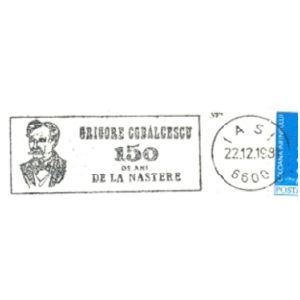 |
 |
 |
|
| 12.01.1982 "125th anniversary of Sabba Stefanescu - geologist and paleontologist" [Sp] [PM1] | 03.03.1982 "Petroșani Mining Museum" [Sp] [PS1] | 25.04.1982 "Bear's Cave" [Sp] | |
 |
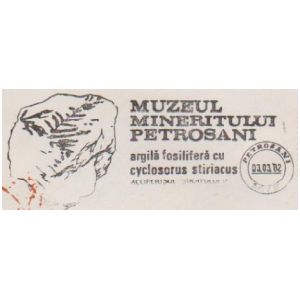 |
 |
|
| 25.12.1982 "Natural History Museum of Grigore Antipa" [Sp] | 09.10.1983 "International philatelic show Geospepa'83" [Sp] | 12.11.1983 "Expogeo philatelic show" [Sp] | |
 |
 |
 |
|
| 09.06.1985 "International philatelic show Geospepa'85" [Sp] | 14.09.1986 "Paleontological reserve Soceni" [Sp] | 09.08.1987 "International philatelic show Geospepa'87" [Sp] | |
 |
 |
 |
|
| 10.12.1989 "International philatelic show Geospepa'89" [Sp] | 28.04.1990 "International philatelic show - Viata Satuluni" [Sp] | ||
 |
 |
|
|
| 15.02.1993 "Prehistoric animals: Mammuthus meridionalis" [Sp] | 15.02.1993 "Prehistoric animals: Mammuthus trogontherii" [Sp] | 16.02.1993 "Prehistoric animals: Deinotherium giganteum" [Sp] | |
 |
 |
 |
|
| 16.02.1993 "Prehistoric animals: Ursus Spelaeus" [Sp] | 17.02.1993 "Prehistoric animals: Bison Priscus" [Sp] | 17.02.1993 "Prehistoric animals: Megaceros eurycerus" [Sp] | |
 |
 |
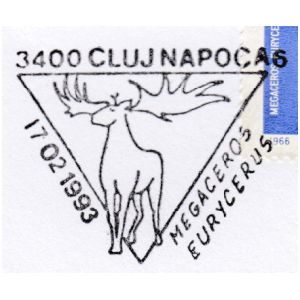 |
|
| 18.02.1993 "60 years since the National Museum of Natural History was renamed the Grigore Antipa National Museum of Natural History" [Sp] | |||
 |
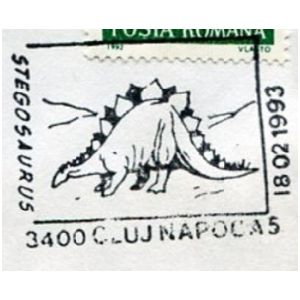 |
|
|
| 19.02. & 20.02. 1993 "60 years since the National Museum of Natural History was renamed the Grigore Antipa National Museum of Natural History" [Sp] | |||
 |
 |
 |
|
| 20.02.1993 "60 years since the National Museum of Natural History was renamed the Grigore Antipa National Museum of Natural History" [Sp] | 30.07.1993 "Prehistoric animals" [FDC] | 02.10.1993 "Jurassic creatures: Plesiosaurus" [Sp] | |
 |
 |
 |
|
| 05.10.1993 "Jurassic creatures: Triceratops" [Sp] | 07.10.1993 "Jurassic creatures: Stegosaurus" [Sp] | 11.10.1993 "Jurassic creatures: Tyrannosaurus" [Sp] | |
 |
 |
 |
|
| 12.10.1993 "Jurassic creatures: Brontosaurus" [Sp] | 13.10.1993 "Jurassic creatures: Archaeopteryx" [Sp] | 22.10.1993 "Prehistoric animals: Archaeopteryx" [Sp] | |
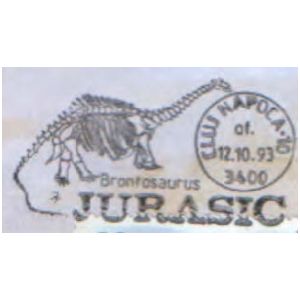 |
 |
 |
|
| 23.10.1993 "Prehistoric animals: Tyrannosaurus" [Sp] | 23.10.1993 "Prehistoric animals: Brontosaurus" [Sp] | 22.10.1993 "Prehistoric animals: Plesiosaurus" [Sp] | |
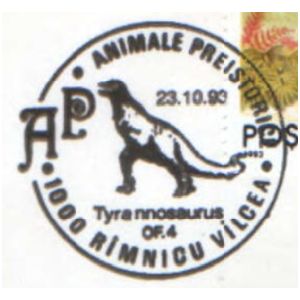 |
 |
 |
|
| 22.10.1993 "Prehistoric animals: Stegosaurus" [Sp] | 23.10.1993 "Prehistoric animals: Triceratops" [Sp] | 02.11.1993 "Jurassic park: Brontosaurus" [Sp] | |
 |
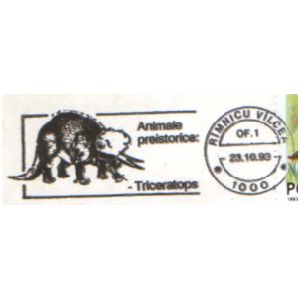 |
 |
|
| 02.11.1993 "Jurassic park: Stegosaurus" [Sp] | 04.11.1993 "Jurassic park: Tyrannosaurus" [Sp] | 04.11.1993 "Jurassic park: Triceratops" [Sp] | |
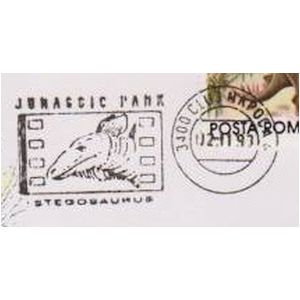 |
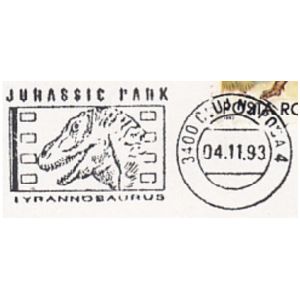 |
 |
|
| 04.11.1993 "Jurassic park: Plesiosaurus" [Sp] | 09.03.1994 "50 years since death of Grigore Antipa" [Sp] | 07.01.1994 "50 years since death of Romanian paleontologist Ion Simionescu" [Sp] [PM2] | |
 |
 |
 |
|
| 30.04.1994 "Dinosaurs" [FDC] | 02.06.1994 "AL II-LEA Fossil and Minerals show: Struthiosaurus transsylvanicus" [Sp] | 03.06.1994 "AL II-LEA Fossil and Minerals show: Megalosaurus" [Sp] | |
 |
 |
 |
|
| 03.06.1994 "AL II-LEA Fossil and Minerals show: Gallimimus" [Sp] | 04.06.1994 "AL II-LEA Fossil and Minerals show: Parasaurolophus" [Sp] | 04.06.1994 "AL II-LEA Fossil and Minerals show: Camarasaurus" [Sp] | |
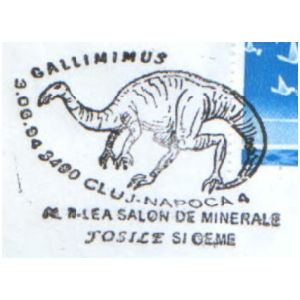 |
 |
 |
|
| 08.06.1994 "AL II-LEA Fossil and Minerals show: Stenonychosaurus" [Sp] | 22.08.1994 Prehistoric animals: Plesiosaurus" [Sp] | 23.08.1994 Prehistoric animals: Triceratops" [Sp] | |
 |
 |
 |
|
| 24.08.1994 Prehistoric animals: Archaeopteryx" [Sp] | 25.08.1994 Prehistoric animals: Brontosaurus" [Sp] | 26.08.1994 Prehistoric animals: Stegosaurus" [Sp] | |
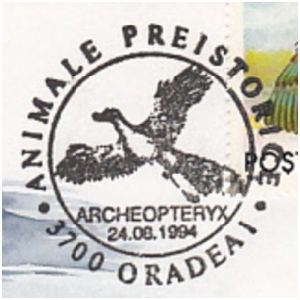 |
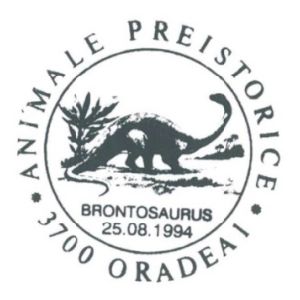 |
 |
|
| 27.08.1994 Prehistoric animals: Tyrannosaurus" [Sp] | 29.08.1994 "Deinonychus" [Sp] | 29.08.1994 "Pterodactylus" [Sp] | |
 |
 |
 |
|
| 31.08.1994 "Iguanodon" [Sp] | 29.08.1994 "Pteranodon" [Sp] | 19.09.1994 "10th philatelic show of Polar Philately" [Sp] | |
 |
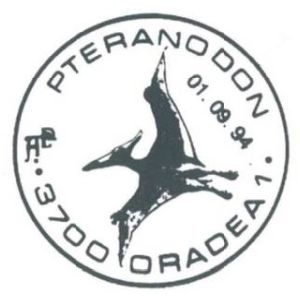 |
 |
|
| 12.12.1994 "Zoological Museum in Cluj Napoca: Pteranodon" [Sp] | 12.12.1994 "Zoological Museum in Cluj Napoca: Iguanodon" [Sp] | 13.12.1994 "Zoological Museum in Cluj Napoca: Pterodactylus" [Sp] | |
 |
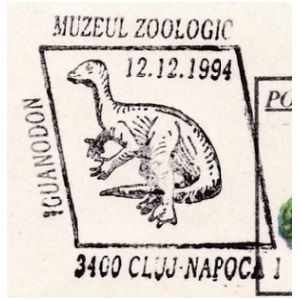 |
 |
|
| 13.12.1994 "Zoological Museum in Cluj Napoca: Deinonychus" [Sp] | 20.01.1995 "Kokoro dinosaurs show at Geology Museum of Bucharest" [Sp] | 01.06.1995 "Pro-Natura'95 show: Camarasaurus" [Sp] | |
 |
 |
 |
|
| 06.06.1995 "Pro-Natura'95 show: Struthiosaurus transsylvanicus" [Sp] | 07.06.1995 "Pro-Natura'95 show: Stenonychosaurus" [Sp] | 05.06.1995 "Pro-Natura'95 show: Megalosaurus" [Sp] | |
 |
 |
 |
|
| 05.06.1995 "Pro-Natura'95 show: Parasaurolophus" [Sp] | 09.06.1995 "Pro-Natura'95 show: Galliminus" [Sp] | 07.12.1997 "130th anniversary of Grigore Antipa" [Sp] | |
 |
 |
 |
|
| 04.08.1999 "Australanthropus Olteniesis" [Sp] | 02.10.2000 "Australanthropus Olteniesis" [Sp] | 20.11.2000 "Prehistoric animals: Parasaurolophus" [Sp] | |
 |
 |
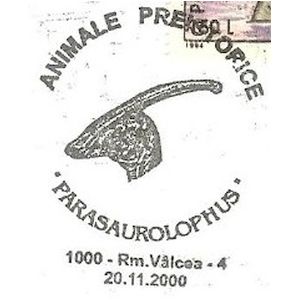 |
|
| 20.11.2000 "Prehistoric animals: Parasaurolophus" [Sp] | 09.04.2002 "Prehistoric animals: Stegosaurus" [Sp] | 09.04.2002 "Prehistoric animals: Tyrannosaurus rex" [Sp] | |
 |
 |
 |
|
| 24.02.2003 "Prehistoric animals: Edmontosaurus" [Sp] | 26.02.2003 "Prehistoric animals: Megalosaurus" [Sp] | 16.10.2003 "Fossil "Ion" Homo Sapiens the oldest in Europe" [Sp] | |
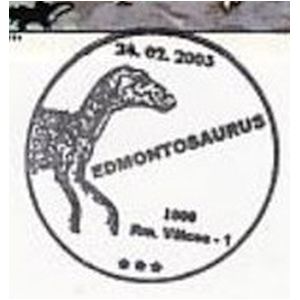 |
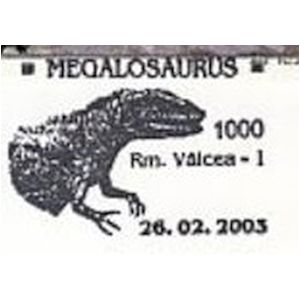 |
 |
|
| 06.12.2003 "AL XL Fossil and Minerals show: Struthiosaurus transylvanicus" [Sp] | 19.01.2004 "XV Polar stamps show" [Sp] | 28.02.2004 "XVI Nationals Minerals and Fossils show" [Sp] | |
 |
 |
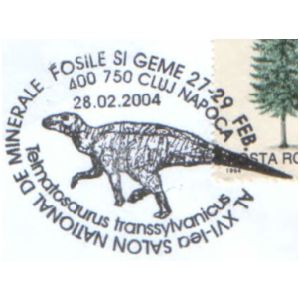 |
|
| 25.02.2005 "Dinosaurs from Tara Hategului - Romania" [FDC] | 02.12.2005 "XVII Nationals Minerals and Fossils show" [Sp] | 15.12.2005 "The third decade of Geospepa thematical group: Archaeopteryx" [Sp] | |
 |
 |
 |
|
| 17.05.2007 "100th anniversary of Biospeleology: Ursus spelaeus" [Sp] | 24.03.2008 "150th anniversary of Eduard Toll" [Sp] [PM4] | 07.04.2009 "200th anniversary of Charles Darwin" [Sp] | |
 |
 |
 |
|
| 21.02.2011 "100 years since death of Romanian paleontologist Grigoriu Stefanescu" [Sp] [PM3] | 12.04.2011 "30th anniversary of Geospepa philatelic club - Geology, Speleology, Paleontology" [Sp] | 16.01.2012 "Cave painting" [Sp] | |
 |
 |
 |
|
| 24.01.2012 "150th anniversary of Romanian paleontoogist Grigore Cobilcescu" [Sp] [2] | 15.10.2012 "Prehistoric animals" [Sp] | 10.07.2013 "140th anniversary of Romanian paleontologist Ion Simionescu" [Sp] [PM2] | |
 |
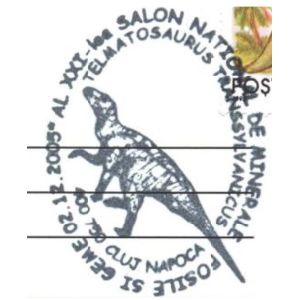 |
 |
|
| 22.01.2016 "Prehistoric animals" [FDC] | 12.04.2018 "Prehistoric animals: Dinosaurs" [Sp] - |
19.04.2018 "Human Evolution" [Sp] - |
|
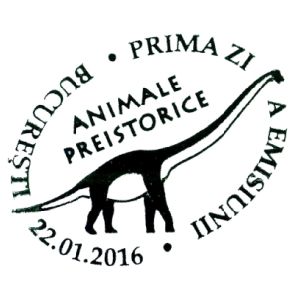 |
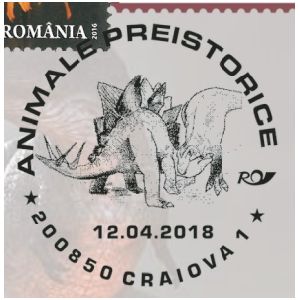 |
 |
|
Notes:
[PM1] Sabba Ștefănescu (January 12, 1857 - August 16, 1931) was a Romanian paleontologist and geologist, professor of paleontology at the University of Bucharest, a corresponding member of the Romanian Academy, who studied the evolution of mastodons and elephants, as evidenced by the fossils of Pliocene and Pleistocene fossils he researched in the country and during his stay in Paris. [R9]
[PM2] Ion Th. Simionescu (born as Ion Gheorghiu; July 10, 1873—January 7, 1944) was a Romanian geologist, paleontologist and naturalist.
He wrote extensively about paleontology and stratigraphy, describing 707 taxa, of which at least 98 were previously unknown. Over the course of seventeen paleontological works, he named and defined the Volhynian, Bessarabian and Khersonian substages of the Sarmatian. [R10]
[PM3] Grigoriu Ștefănescu (1836–1911) was a Wallachian-born Romanian geologist, mineralogist paleontologist. Together with Grigore Cobălcescu, he is the founder of the Romanian school of earth sciences (geology, mineralogy, paleontology). [R11]
[PM4] Eduard Gustav Freiherr von Toll (14 March 1858 – 1902), often referred to as Baron von Toll, was a Russian geologist and Arctic explorer. He was most notable for leading the Russian polar expedition of 1900–1902 to the legendary Sannikov Land.
It is less known that in 1893, he led an expedition to Siberia along the Siberian Sea with the goal of finding the remains of Mammoths to bring them back to Saint Petersburg.
Unfortunately, he was only able to find and unearth a few bones of the animal. These bones are depicted on the bottom-left corner of the postmark. [R12]
Other commemorative postmarks of Romania to consider: Natural History Museums, flint tools
Legend is here| 15.04.1980 "Hand ax" [Sp] | 10.05.1980 "Bone tools" [Sp] | 20.05.1980 "Bone tools" [Sp] |
 |
 |
 |
| 15.11.1983 "115th anniversary of Emil Racovita" [Sp] [A3] | 29.03.1987 "75 years since death of Captain Robert Falcon Scott" [Sp] [PMO1] | 15.11.1988 "Emil Racovita" [Sp] [A3] |
 |
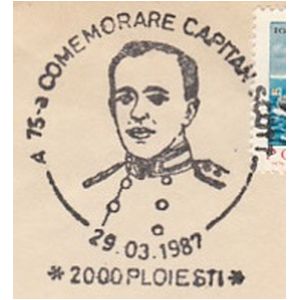 |
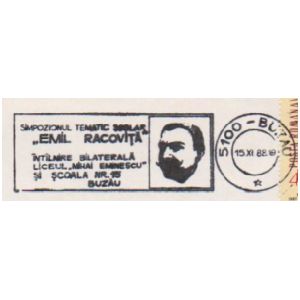 |
| 16.08.1992 "Speleology in Romania" [Sp] [A3] | 03.10.2000 "Bones of Australanthropus Olteniesis" [Sp] | 04.10.2000 "Hand ax" [Sp] |
 |
 |
 |
| 05.10.2000 "Silex tools " [Sp] | 06.10.2000 "Silex tools" [Sp] | 06.03.2002 "Bone tools" [Sp] |
 |
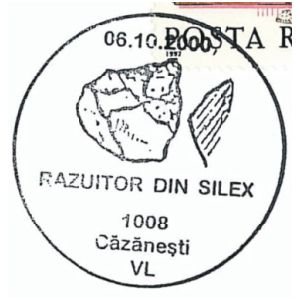 |
 |
| 05.02.2002 "Bone tools" [Sp] | 01.11.2005 "125th anniversary of Alfred Wegener" [Sp] [PMO2] | 19.05.2007 "Emil Racovita" [Sp] [A4] |
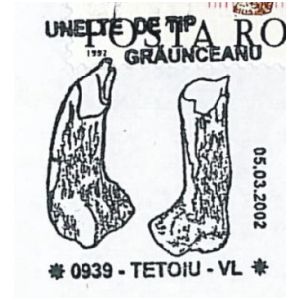 |
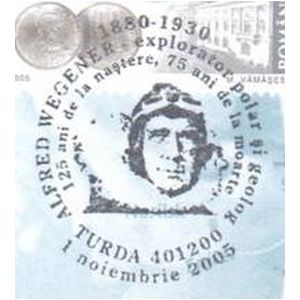 |
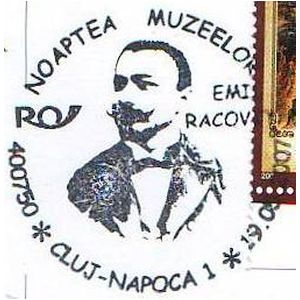 |
| 20.05.2008 "Centenary of National Natural History Museum" [FDC] | 12.05.2010 "115 years of Natural History Museum" [Sp] | 29.03.2012 "100th anniversary of Robert Falcon Scott" [Sp] [PMO1] |
 |
 |

|
| 12.05.2015 "120 years of Natural History Museum" [Sp] | 18.06.2020 "Institute of Speleology 'Emil Racovita', a century of research" [FDC] [A3] | |
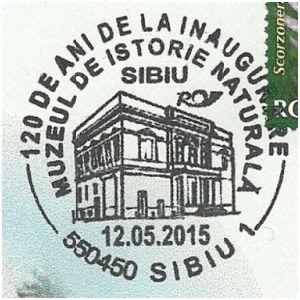 |
 |
|
Notes:
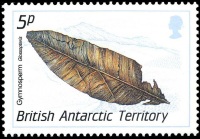
|
| Glossopteris on stamp British Antarctic Territory 1990 MiNr.: 160, Scott: 157 |
Scott and his companions died on the second expedition. When Scott and his party's bodies were discovered, 16kg of Glossopteris (an extinct beech-like tree from 250 million years old) fossils from the Queen Maud Mountains were found next to their bodies, which they had dragged on hand sledges.
These fossils were promised to Marie Stopes (shown on UK stamp in 2008) to provide evidence for Eduard Suess's idea that Antarctica had once been part of an ancient super-continent named Gondwanaland (now Gondwana). More details are here.
Note: Robert Falcon Scott was honoured on several stamps of British Antarctic Territory and UK , as well as on several international postmarks.
[PMO2] Alfred Lothar Wegener (1880 -1930) was a German scientist, geophysicist, and meteorologist.
He is most notable for his theory of continental drift (Kontinentalverschiebung), proposed in 1912, which hypothesized that the continents were slowly drifting around the Earth.
Note: Alfred Lothar Wegener was honoured on several German (Berlin, DDR ) and Austrian stamps in 1980, as well as on several international postmarks.
References:
- [R1] Romania:
Wikipedia,
WikiTravel,
FlagCounter.
- [R2] Postal History and Philately of Romania:
Wikipedia,
Links to official website of the Post Authority, stamp catalog and a list of new stamps of Romania are here - [R3] Grigores Antipa: Wikipedia
- [R4] Grigore Cobilcescu: Wikipedia, Repedea Hill Fossil Site (Wikipedia),
- [R5] Emil Racovita: Wikipedia
- [R6] The Petroșani Mining Museum: Wikipedia
- [R7] Carl von Linné: Wikipedia
- [R8] National Geology Museum of Romania: official website (in Romanian), Wikipedia
- [R9] Sabba Ștefănescu: Ion Sabba Ştefănescu's homepage Wikipedia (in Romanian)
- [R10] Ion Th. Simionescu: Wikipedia ,
- [R11] Grigoriu Ștefănescu: Wikipedia (English article is very short) Wikipedia (in Romanian)
- [R12] Eduard Gustav Freiherr von Toll: Wikipedia
- [R13] Alfred Lothar Wegener: Wikipedia
Acknowledgements:
Many thanks to
- Dr. Peter Voice from Department of Geological and Environmental Sciences, Western Michigan University, for the draft page review and his valuable comments.
- fellow collector Peter Brandhuber from Germany and Mr. Alexander Pedchenko from Russia, for their help in finding some missing philatelic stuff of Romania.
| << previous country | back to index | next country >> |